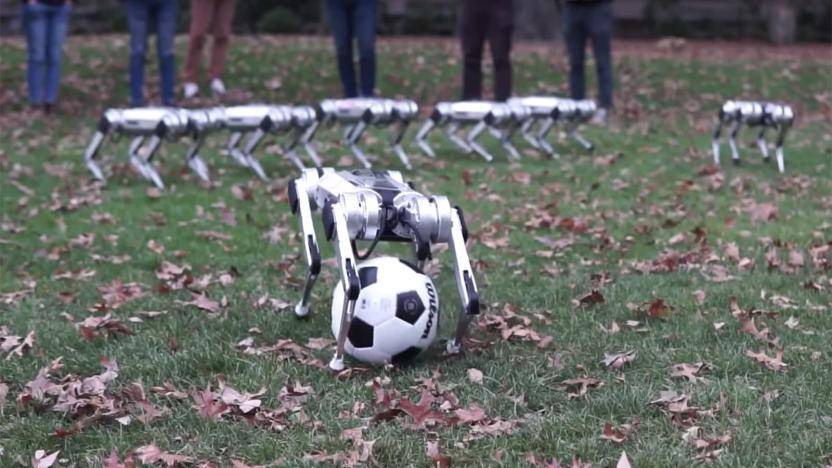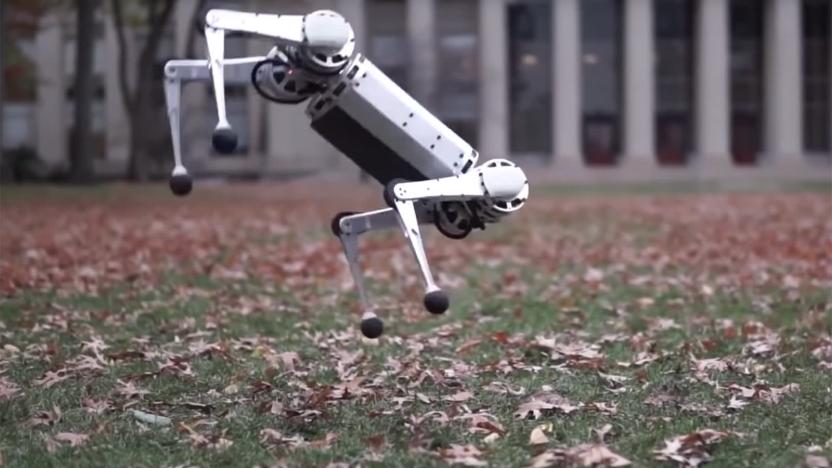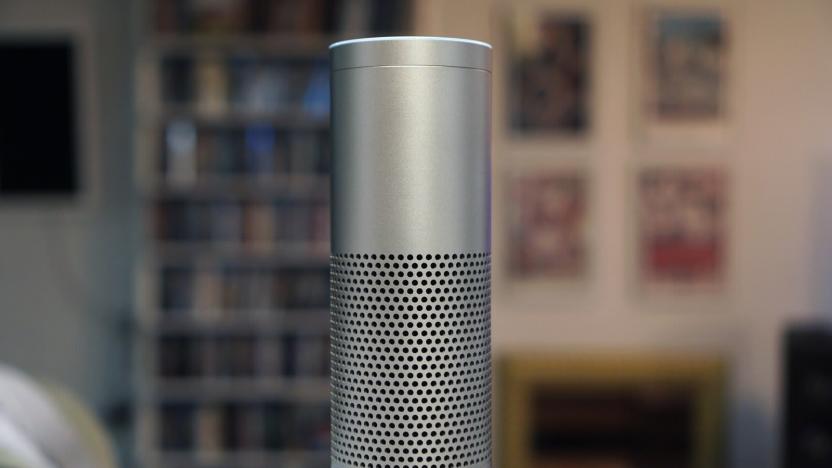robopocalypse
Latest

Robots are learning to brace themselves against walls to avoid falling
Robots are learning to prevent falls by propping against a wall, much like a human.

Boston Dynamics' robots can parkour better than you
Boston Dynamics' robots are now successfully performing parkour in an obstacle course — let's hope they don't have to chase us.

Watch a herd of MIT's Mini Cheetah robots frolic in the fall leaves
MIT wants to show that its Mini Cheetah robots aren't just solitary creatures. The school's Biomimetics department has posted a video of nine of the bots frolicking in the fall leaves, showing just what these pet-sized quadrupeds can do. The remote-controlled machines can backflip out of leaf piles, kick a soccer ball and have friendly tussles... well, if a bodyslam can be considered friendly. There's even some eerie coordinated dancing, in case you want to know how robots will socialize once the robopocalypse is over.

MIT's Mini Cheetah robot knows how to do backflips
MIT's original Cheetah robot is already quite nimble on its feet, but there's now a smaller counterpart that might put it to shame. Researchers have shown off a new Mini Cheetah that can pull off a number of slick moves, including backflips -- it's the first four-legged robot to pull off the feat, according to MIT. It can also walk upside-down Exorcist-style, pick itself up after falls and trot at a relatively brisk 5.5MPH on less-than-smooth terrain.

Alexa is randomly laughing, and it's creepy as hell (updated)
If you have an Alexa-powered device, you'd be forgiven for thinking it was haunted: users have been complaining that their devices would laugh randomly or simply refuse to do what they were asked. Is your smart speaker going to murder you in your sleep? Thankfully, no. Amazon has confirmed that it's aware of the problem and is "working to fix it." The company hasn't said what went wrong, but it's notable that this isn't a case of accidentally triggering the voice assistant -- the laughter has kicked in without triggering the signature blue light that accompanies responses on Echo speakers and other Alexa devices.

Boston Dynamics' robots won't be held back by puny humans
Are you looking for the exact moment when the robots decide to turn on their human creators? You might want to mark this day on your calendar. Boston Dynamics has posted video of a SpotMini test where it gauged the bot's ability to adjust to interference -- in this case, from a pesky human. The quadruped managed to open a door despite a human pushing its hand down with a hockey stick, pushing the door closed and even tugging on its 'tail.' It clearly struggled, but its ability to adapt and rebalance left it unfazed.

Boston Dynamics' robots are the politest 'pets' you'll meet
We hope you weren't planning on sleeping tonight. Boston Dynamics has posted a video showing that its SpotMini robot can hold the door open for its fellow automatons. If one bot needs a helping hand, it'll signal to another machine nearby that can pry the door open and let it through. It's very polite... and more than a little unsettling, especially since it's not clear they'll extend the same courtesy to humans. At least the robots will have manners when they take over.

Robots could wear flesh to help form transplants
Right now, you have to grow human transplants in a stationary environment. That's more than a little dangerous when they could buckle under the stresses of a real body. Oxford University may have a clever (if slightly ghastly) solution to that problem: have robots wear the tissue first. If you grow muscles on humanoid robots, the movement and overall shape of those machines would lead to grafts and transplants that are ready for serious strain.

Sony's Kaz Hirai: 4K and HDR are here, robots are coming
By all accounts, Sony played it safe at CES this year. Outside of an OLED TV that projects sound from its screen, the company was light on game-changing product announcements. So when I sat down with Sony CEO Kazuo Hirai for an exclusive interview, we focused on the topic that's been on everybody's lips this week: artificial intelligence. Last July, Hirai announced that Sony was reinvesting in AI in a big way for the first time since cutting funding in 2006. He says its ambitions go far beyond a refreshed Aibo, but not to rule out the possibility of robopup resurrection. As to whether we should be worried about our autonomous K9s turning into agents of a robot uprising? Hirai says it's up to companies like his to keep the AI hounds at bay. Click here to catch up on the latest news from CES 2017.

Hiring a robot waiter can cost you your business
If you've ever whined that employing people means dealing with their personal messes, don't think hiring robots can make your life any better. Two restaurants in China have been forced to close after replacing their flesh-and-bone waitstaff with robots turned out to be a terrible mistake. According to the Worker's Daily (translated by Shanghaiist), the expensive droids were incapable of taking orders, carrying soup or pouring water. That means that a sophisticated artificial intelligence is being outdone by a 17-year-old on minimum wage with their head in a cloud of marijuana smoke.

Oregon State University's ATRIAS robot takes a walk in the park
We've seen Oregon State University's ATRIAS robot prove its mettle in a controlled environment, sure, but what changes when it goes for a stroll in the great outdoors? Perhaps unsurprisingly, not a whole lot. The biped doesn't have a problem going uphill, downhill, maintaining balance when dodgeballs hit it and even handles variations in terrain with aplomb. It doesn't seem to have any issues changing speed, either. Basically, this proves that the ATRIAS doesn't need perfect conditions to operate, which is important because let's face it: the real world is far from perfect.The upside to all of this is that unlike humans, robots don't quite get stage-fright so replicating these actions in front of a crowd at the DARPA Robotics Challenge come June likely won't be an issue.

UN debates a preemptive ban on killer robots
Killer robots are at the heart of popcorn fare like the Matrix and Terminator movies, but there's a serious debate underlying it all: do we want to trust fully autonomous machines with lethal weapons? Some would argue that it's just too risky, and the United Nations has accordingly held its first meetings discussing a potential ban on the concept before it ever gets off the ground. Critics (including the UN's acting European head, Michael Moeller) argue that deadly robots may not consistently obey humanitarian laws, particularly in tricky situations; they may do things that are logically sound, but morally flawed. There are also worries about accountability, since it may be difficult to hold armies and police forces directly responsible for deaths at their robots' hands.

BYU image algorithm can recognize objects without any human help
Even the smartest object recognition systems tend to require at least some human input to be effective, even if it's just to get the ball rolling. Not a new system from Brigham Young University, however. A team led by Dah-Jye Lee has built a genetic algorithm that decides which features are important all on its own. The code doesn't need to reset whenever it looks for a new object, and it's accurate to the point where it can reliably pick out subtle differences -- different varieties of fish, for instance. There's no word on just when we might see this algorithm reach the real world, but Lee believes that it could spot invasive species and manufacturing defects without requiring constant human oversight. Let's just hope it doesn't decide that we're the invasive species.

DARPA's Cyber Grand Challenge pits bot security systems against each other
It sounds like the seeds of a end-of-days sci-fi hit, but DARPA knows what it's doing, right? It's establishing the first-ever tournament for automated network defenses, in which systems would compete against each other to test vulnerabilities, make security patches, and generally wage digital war on each other. The aim of its Cyber Grand Challenge is to "vastly improve" the effectiveness and speed of DARPA's own IT security, in a digital world rife with what it says are "escalating cyber threats." Dan Kaufman, director of DARPA's Information Innovation Office which organized the Challenge, said: "The trends we've seen in cyber attacks and malware point to a future where automation must be developed to assist IT security analysts." The competition will involve a qualifying stage, where the team would have to pass a series of software challenges, followed by a final event, planned for mid-2016. It could be worth the wait for competitors -- the winners will net $2 million, while second and third place will receive $1 million and $750,000 respectively.

MIT builds modular robots that self-assemble, dooms humanity (video)
Modular robots have long been a reality, but they often require human intervention to assemble or aren't very clever. MIT's new M-Block robots don't need such help. Each cube-shaped machine includes a flywheel and edge magnets, the combination of which lets it attach to its fellow robots simply by spinning into place; the devices can climb over each other and even jump into position. It's a wonderfully simple solution, although we're a bit frightened by MIT's long-term plans. Researchers are writing algorithms that would let M-Blocks act in concert, and swarms of robots could eventually have a Terminator 2-like ability to assume any shape needed to solve a given problem. If the Robopocalypse starts with a flood of colorful cubes, we'll know who to blame.

Boston Dynamics puts AlphaDog through more field training, teaches Atlas robot to hike over rocks
Boston Dynamics' sprinting WildCat robot isn't the only autonomous machine it's letting roam the great outdoors: AlphaDog is still trudging through the wilderness too. A flurry of updates to the firm's YouTube channel reveal that the four-legged robot (officially known as the LS3) has been undergoing field testing in Twentynine Palms CA, which included overcoming rough-terrain, GPS guided maneuvers and endurance tests. It's impressive, as always, as is the outfit's progress with Atlas, a bipedal robot that evolved from Boston Dynamics' Petman. The humanoid machine can now negotiate a rocky walkway with relative ease, adding another party trick to its already impressive repertoire. The video updates didn't say if the machines were ready for the DARPA Robotics Challenge later this winter, but you can get an eyeful of the company's progress after the break.

DARPA's Atlas robot will be taught to save you if the sky falls (video)
DARPA and Boston Dynamics seem bent on engineering the robot revolution, and it's while wearing a suspicious smile that they introduce us to Atlas, their latest humanoid creation. Inorganically evolved from Petman and an intermediate prototype, Atlas will compete in DARPA's Robotics Challenge (DRC) Trials in December, where it will be challenged with "tasks similar to what might be required in a disaster response scenario." The seven teams that made it through the Virtual Robotics Challenge stage, held in a simulated environment, will massage their code into the real 6' 2" robot, which sports a host of sensors and 28 "hydraulically actuated joints." Also competing for a spot in the 2014 DRC finals are six "Track A" teams, including a couple of crews from NASA, which've built their own monstrous spawn. Head past the break for Atlas' video debut, as well as an introduction to the Track A teams and their contributions to Judgement Day.

Robopocalypse: Now liveblog
We'll be discussing the history and near-future of robotics with luminaries from Willow Garage, Boston Dynamics (yes, the people behind Big Dog) and 3D Robotics. Our editor-in-chief, Tim Stevens, is orchestrating proceedings and we'll be liveblogging the whole event right here... in just a few minutes. March 17, 2013 2:15 PM EST

So this is how it ends: DARPA demos a flying drone with a 6-foot claw (video)
While we're well aware that robots will prove our undoing, we didn't expect DARPA to make it so... easy. It just demonstrated and helped fund the MLB Company's V-Bat, a testbed UAV that can fly or hover while brandishing a 6-foot claw. Yes, we know what you're thinking. Officially, there's an innocuous reason for the giant arm: a stereo vision system, in tandem with GPS, lets the robot precisely deliver one-pound payloads with the kind of reach that us fleshy anthropods wouldn't have. We're not quite so comforted after realizing that the robot can find its target without human input, however. DARPA sees the V-Bat as a stepping stone towards more autonomous vehicles, and it likely has noble intentions at heart. If V-Bat's descendants ultimately decide that humans are the payload, though, we'll know exactly who to blame.

The Engadget Show 38: Robopocalypse with Chris Anderson, Daniel H. Wilson and our future robot overlords
Greetings from the distant future of 2013. We stand in a basement of a wasteland once known as "New York City," to deliver you tales of the impending Robopocalypse. We'll take you to "San Diego" where former Wired editor-in-chief Chris Anderson and his 3D Robotics business partner Jordi Muñoz are offering up the technology to help turn robotic helicopters into autonomous drones. Next up, author Daniel H. Wilson discusses his own prophecies in the bestselling Robopocalypse (soon to be a Spielberg-directed motion picture). Wafaa Bilal, the NYU professor who had a camera implanted in the back of his head, tells us about his life as an cyborg -- and what it's like having strangers on the internet shoot you with paintballs. We've got a trip to the Robot Hall of Fame in Pittsburgh where we speak to BigDog creator Marc Raibert, iRobot in Massachusetts, Bot & Dolly and Keepon-maker BeatBots in San Francisco and Willow Garage, home of the PR2. We'll also travel to MIT, Carnegie Mellon, Georgia Tech and Northeastern University to find how some of our nation's top schools are contributing to the forthcoming robotic apocalypse. And, seeing as how it wouldn't be an Engadget Show without the Gadget Table, we crack open a time capsule from 2012, to check out some of the top consumer electronics of the day including the Microsoft Surface, iPad Mini and Nexus 4 and 10. Be sure to watch this very special episode of the Engadget Show. Your life -- and everything you hold dear -- just might depend on it. Download the Show: The Engadget Show - 038 (HD) / The Engadget Show - 038 (iPod / iPhone / Zune formatted) / The Engadget Show - 038 (Small) Subscribe to the Show: [iTunes] Subscribe to the Show directly in iTunes (MP4). [Zune] Subscribe to the Show directly in the Zune Marketplace (MP4). [RSS MP4] Add the Engadget Show feed (MP4) to your RSS aggregator and have it delivered automatically. [HD RSS] Get the Engadget Show delivered automatically in HD. [iPad RSS] Get the Engadget Show in iPad-friendly adaptive format.







